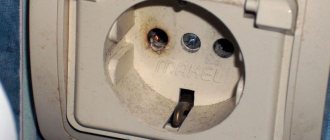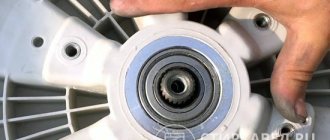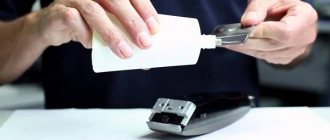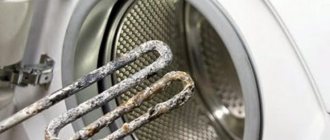All operating modes of automatic washing machines are pre-programmed. They consist of a specific algorithm of actions with set time intervals.
Sometimes situations arise when it is necessary to stop the program execution and open the hatch door. Different models have this option, but not all users know how to do it.
- Can the door be opened during operation?
- How to stop the program and open the hatch
- Water drain options
- What to do if the door is jammed after an emergency shutdown?
- Catalog of washing machines with reviews
Can the door be opened during operation?
The reason for the need to open the hatch of the washing machine can be any non-standard situation as a result of which this needs to be done. For example, the user forgot to remove an item from the item's pocket before putting it into the drum and started the wash cycle. Or you need to add more laundry. In fact, there may be many reasons why there may be a need to open the hatch door during program execution.
hatch sma
After the wash starts, the door is locked. This is done by manufacturers to comply with safety measures. It cannot be opened until the cycle ends.
Expert opinion
I work in the household appliance repair industry. Extensive experience in restoring washing machines and dishwashers.
Ask a Question
Attention! Using excessive force to open the hatch door during washing may damage it.
How to stop the program and open the hatch
There are several ways to stop a loop from running. Naturally, you can simply turn off the power supply, then the operation of the device will be stopped.
Unfortunately, this manipulation will not help open the hatch door. Moreover, doing this is strictly prohibited. An abrupt disconnection from the network may cause the software to crash.
Do you turn off the water tap after washing?
Oh yes! No.
Start button
For most models, you can stop and cancel the program by long pressing the “Start” button. After the indicator starts flashing, the button must be released and after 1-2 minutes, depending on the model, the door will unlock.
If it is not possible to use the first method, you can use others. The washing program will stop if you return the switch to its original position. Then you need to select the drain or spin option. Some models have an emergency drain function.
"Pause"
Almost all automatic washing machines have a “Pause” button on the panel. With its help you can stop the operation of the device. For most models, this option is regulated by the duration or number of presses.
After the pause starts, the power indicator starts flashing and the program execution stops. After a minute or two the door will unlock.
If there is no Pause button?
In this case, you can use a mechanical manual switch, setting it to its original position. After which the device must be disconnected from the network and wait until the door opens.
Program switch
Both options work the same, but they can be used if there is no water in the drum. If it is there, it will need to be drained first. In the case of vertical washing machines, there is no need to drain the water.
How to open if there is water in the drum?
If there is water in the drum of the front washing machine, when the hatch door is opened, it will splash out onto the floor. Therefore, it must first be drained, and then the door must be unlocked.
If there is no emergency drain in the machine’s functionality, you can start a push-up. As a rule, after this the door will open on its own. A more successful way to start the drain, if such an option is available.
How to disconnect a washing machine: from the water supply, sewerage, preparation for transportation
Automatic washing machines, as you know, are installed in a pre-selected prepared place where there are all the necessary communications. However, sometimes cases arise when you need to turn off the device and move it to another location. For example, when renovating a bathroom or purchasing new washing equipment. You will learn how to disconnect a washing machine from the water supply in this article.
Required Tools
You can disconnect the machine from the water supply without using tools at all. It all depends on the method of connecting the washing machine to the water supply, as well as on the type of inlet hose of the machine.
Installation and dismantling of the inlet hose is done by hand if there are plastic nuts and fittings at both ends. Plastic parts are fragile and need to be handled without tools.
This type of hose is more common than others. It is supplied complete with washing equipment. However, it is often changed to another.
How to turn off the machine yourself?
Disconnecting the machine from the water supply is carried out as follows:
- Disconnect the washing equipment from the power supply. This cannot be done during the washing process.
- Next, turn off the water supply valve to the machine. This tap is usually located either behind the appliance or under the sink.
- Move the washer away from the wall. At this moment, you need to make sure that the tension in the hoses (drain and fill) is not too strong.
- Next, you need to lay rags on the floor and prepare a bucket for water.
- The hose nut should be unscrewed. This is done counterclockwise. Then disconnect the hose itself from the washer. Do not exert great force when working with the tool. Otherwise, the thread may be stripped or the nut may be damaged.
- Next, you need to drain the water from the hose into a bucket.
- In the same way, you need to unscrew the inlet hose from the pipe or tee. At this point, the disconnection of the inlet hose is completed.
It should be noted that complete dismantling of the machine does not end with disconnecting the inlet hose. To transport the washing machine, you must also disconnect the drain hose from the sewer pipe.
Carefully disconnect the drain hose from the sewer pipe and drain the remaining water into a bucket.
Proper transportation of equipment
Washing equipment must be prepared in advance for transportation. First you need to wind up the power cord and then secure it on the back side with a clamp.
Next, you need to dry the inlet hose, and then secure it on the back side with a clamp. The same must be done with the drain hose.
It is also important to check that there is no water in the powder tray. To do this, wipe it with a dry cloth. Next, you need to drain the water and clean the drain filter.
At the last stage, you need to put plugs on all the holes from the hoses and secure the tank of the machine using shipping bolts. The device must be transported in an upright position.
So, in this article we found out how to disconnect the washing machine from the water supply yourself. This work is not at all difficult and almost anyone can cope with it.
Water drain options
If it is not possible to stop the work using the software buttons, and there is no point in starting the spin mode. For example, when a mobile phone or bank card is left in your jacket pocket, you need to act immediately, because further work can damage them. In this case, you need to use the emergency drain function.
Drain pipe
Emergency water drain
In the bottom right corner under the removable panel of the washing machine there is a drain tube. It is protected by a plug. Place a container at an angle into which the water will drain. The plug will need to be removed and the hose lowered into the reservoir.
If there is no tube, the water comes out directly. This must be provided for before you start draining, and stock up on a towel and a spare container. A basin or bucket wouldn't hurt.
Drain hose
The location of the drain hose depends on the design of the washing machine. Most often it is located at the bottom at the back, but in some brands, for example Bosch. This method cannot be used on such machines.
Drain hose
When located below, it must be disconnected from the sewer and the housing. Then place it in a container of sufficient size. When the bulk of the water has gone, you can throw the hose on the floor and collect the remainder with a rag.
Expert opinion
I work in the household appliance repair industry. Extensive experience in restoring washing machines and dishwashers.
Ask a Question
If there is no blockage, perhaps the easiest way.
Pipe branch
Draining water using a spigot is not the easiest option for the average user. Its blockage is the reason why the water does not drain.
Then the problem is solved by dismantling and cleaning the pipe. After this manipulation, drainage becomes possible. The process is quite complex and requires partial disassembly.
Therefore, it is better to use an alternative option.
Connection between tank and pump
Via pump filter
If the washing machine does not have the “Drain” function, and the “Spin” function cannot be used, you can urgently remove the water manually using the pump filter. It is located below the drum hatch. More details:
- It is necessary to stop the washing machine using the control functionality.
- Turn off the power supply by unplugging the plug from the outlet.
- Take a container with sides, for example a basin, and place it under the filter.
- Slowly unscrew the filter valve.
- Wait until the water drains into the container. If the tank is full, you will have to periodically stop the process to empty the container.
- Open the drum.
Important! After this, the program must be started again.
SMA drain pump filter concentrator
What to do if the drum is full of water
Many washing machines have a sensor for the remaining water in the drum. Until you ensure the water drains, the hatch door will be blocked. There is nothing complicated in the procedure. Proceed according to the scheme below:
- to stop the device, press the “Turn Off” button on the control panel;
- activate the "Drain" function. If it is missing, use “Spin”;
- After draining, the hatch lock will be automatically released.
In emergency cases, you will have to drain the water manually using the drain valve filter. It is located on the front panel of the device, in its lower part. Follow these guidelines:
- Turn off the washing machine using the corresponding button on the control panel.
- Unplug the cord from the outlet.
- Take a small basin (preferably with low sides) and place it near the machine.
- Open the filter hinged door and slowly unscrew the valve.
- Wait until all the water has drained into the container.
- Now the hatch can be opened and the laundry pulled out.
After this unlocking method, it will not be possible to continue washing from the moment you stopped. You need to start the cycle again.
What to do if the door is jammed after an emergency shutdown?
It is not advisable to open the hatch after starting the washing program. There are situations when, after an urgent shutdown, the door gets jammed.
The problem is easily solved if there is an emergency cable. It is located next to the drain hose. If it is not available, you can use a thin spatula.
They should grab the door and pull it towards themselves. An alternative option is to use a boot cord. Let's take a closer look.
Emergency opening with a cable
Some automatic washing machines are equipped with a cable. It can be used to open a locked door. It is located below, near the filter. Manufacturers most often make the cable contrasting so that it can be easily found. The hatch lock will unlock if you gently pull it.
Expert opinion
I work in the household appliance repair industry. Extensive experience in restoring washing machines and dishwashers.
Ask a Question
Note that it is present only in expensive models with an electronic sunroof lock.
Emergency opening of the washing machine hatch
Open using cord
If there is no cable included, you can replace it with a thin synthetic cord or strong fishing line. This method doesn't always work, but it's worth a try. It is necessary to determine whether the design of the lock allows it to be opened in this way.
You can use it in a situation where the latch lock is located in the direction of the body. If he “looks” in the other direction, then you won’t be able to open the machine this way.
The cord should be wrapped around the circumference of the hatch so that it fits between the body and the door. Then gently pull it towards you. If you can’t open it, then you shouldn’t bother.
Are you unplugging your washing machine?
Oh yes! No
Open with a spatula
A simple and reliable way to open the hatch of a washing machine using a spatula. Thin and flexible will do. We repeat the steps described above.
They should pry the hatch and pull it towards themselves. There is no need to put in excessive effort. If the method does not work, it is better to use another method.
Press the hook from the inside
In some lock designs, this method is not possible. For example, if the UBL is a closed structure. But this is rare. The essence of the method is to get to the lock hook from inside the car.
UBL washing machine
To do this, you need a tool, certain technical skills and physical effort. First you need to drain the water in any available way. After this, turn off the power supply to the device.
Expert opinion
I work in the household appliance repair industry. Extensive experience in restoring washing machines and dishwashers.
Ask a Question
Attention! Sometimes removing the panel is the only option to open the washing machine. It is advisable to read the instructions first.
First you need to remove the top cover and move the machine away from the wall. Using your hand, remove the lock latch from the inside and open it. After unlocking the hatch, put the device back in its previous position and return the cover.
Are you using citric acid?
Oh yes! No
Detailed step-by-step instructions:
- Remove the top cover.
- Armed with a flashlight, we determine the location of the lock on the body. And also the location of the hook. It is usually made of silumin alloy, shiny silver color.
- Then, take a short metal object with a rather thin end. A screwdriver will do.
- We put our hand in. We find a lock and a hook. Then use a screwdriver to pick it up and move it left or right.
- In this case, you need to simultaneously pull the hatch.
Special wrenches may be needed to remove the panel. As a rule, simple screwdrivers are sufficient, but sometimes Torx screwdrivers are needed.
Important! All of the above methods should be used as rarely as possible. Therefore, it is necessary to follow the operating rules to avoid emergency situations.
Basically, washing machines have the function of stopping the program, draining the water and unlocking the door. Unfortunately, not all models have this option.
If it is missing, there is no need to worry. You can use one of the options described above and open the washing machine hatch .
How to disconnect a washing machine from the water supply?
A washing machine is a piece of furniture in a kitchen or bathroom that is rarely moved and therefore disconnected from the water supply. However, there may be times when instructions on how to turn off the machine may be required. For example, the car has broken down and needs to be dismantled and transported to a service center, it has been decided to replace old equipment with new ones, renovations are planned in the room, or even the washing machine needs to be transported to a new place of residence. So, let's figure it out how to properly disconnect the water supply.
Do you need a tool?
Depending on how the machine is connected to the water supply and what type of hose is on the washing machine, a tool may not be required for the job.
If the inlet hose has plastic fittings and nuts at both ends, then they must be connected and dismantled by hand, since plastic material is fragile. This is the most common hose that comes with the machine. However, its length is not always enough and it is replaced with another one.
If there is a metal nut at the end of the hose that can rust to the tee or pipe over time, you may need pliers or a small wrench depending on the size of the nut. If the connection is secured with a clamp, then a Phillips or straight screwdriver will be useful.
WD-40 liquid will help remove rust and make it easier to unscrew the filler hose.
Shutdown algorithm
Now let's look at what order and what to do when you need to safely disconnect the washing machine from the water supply.
- We disconnect the washing machine from the network when the washing process is completed. This should not be done during washing.
- Turn off the water supply tap to the washing machine. As a rule, it is located behind the washing machine or under the sink if the machine is installed in the kitchen.
- We move the machine away from the wall or pull it out of the kitchen unit so that you can freely go behind the machine. In this case, the inlet and drain hoses should not be too tight.
- We take a bucket under the water and put rags on the floor in case water starts to flow.
- Disconnect the hose from the machine by unscrewing the nut counterclockwise.
When using the tool, do not apply excessive force, otherwise you may damage the nut and strip the threads.
- We tilt the hose into a bucket and drain the remaining water.
- Similarly, unscrew the hose from the tee or pipe. Removal of the inlet hose is complete.
Dismantling the entire washing machine does not end with disconnecting the inlet hose. To be able to move the machine to another room or transport it, you must also disconnect the drain hose from the sewer. Of course, if the hose was simply thrown over the side of the bathtub, then practically nothing needs to be done here. But when connecting the drain hose to the sewer, it must be carefully disconnected . The drain hose is removed from the branch sewer pipe. The remaining water is poured into a bucket.










